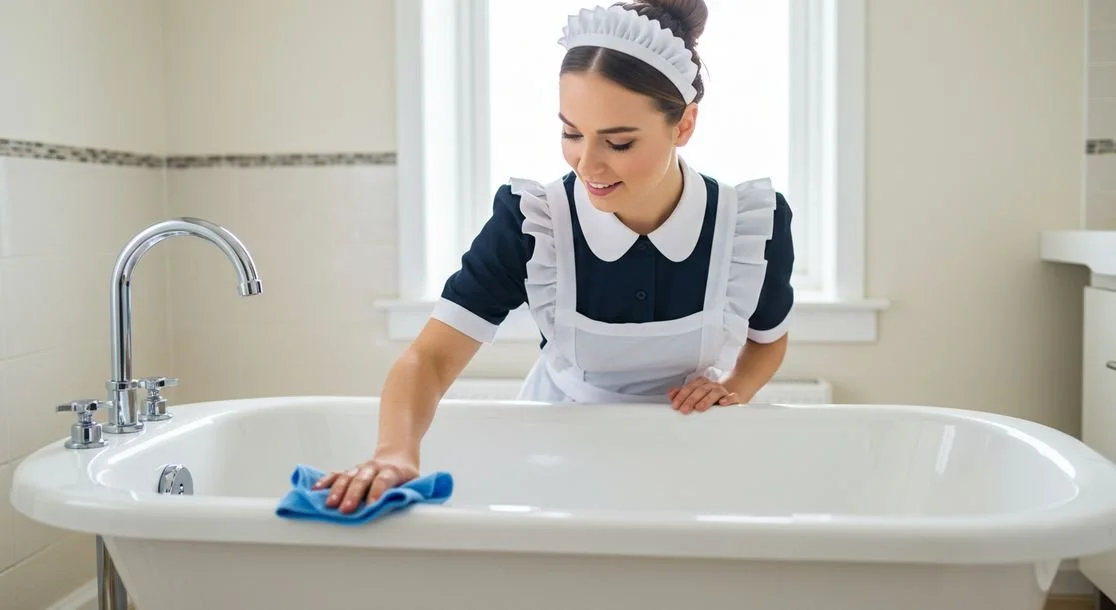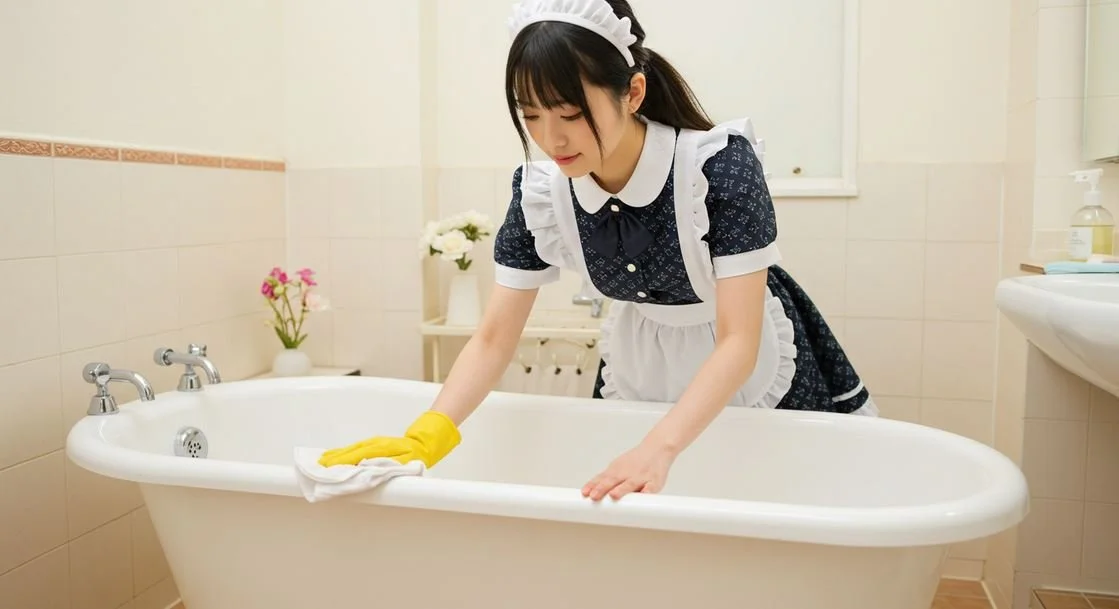How To Clean A Plastic Bathtub (Easy Guide)
Cleaning a plastic bathtub isn’t exactly the most exciting chore, but it’s one of those little things that makes a big difference in how fresh your bathroom feels.
Over time, soap scum, grime, and hard water stains can make even a bright white tub look dull and tired.
The good news? You don’t need fancy cleaners or hours of scrubbing to get it sparkling again. With just a few simple ingredients, you can bring back that clean, smooth shine in no time.
In this post, we’ll show you how to clean a plastic bathtub.
What You’ll Need
You won’t have to raid the cleaning aisle for this one. Most of what you need is already sitting in your kitchen or laundry area.
Here’s what you need to clean a plastic bathtub:
Baking soda
White vinegar or dish soap
Soft sponge or microfiber cloth
Warm water
Small bowl or spray bottle
Clean towel or rag
That’s it. Simple ingredients, easy steps, big results.
Also Read: What To Clean An Acrylic Tub With
Step 1: Rinse The Tub
Before you dive into deep cleaning, start by giving your tub a solid rinse.
Warm water works best because it helps loosen up dirt, soap residue, and any oily buildup. Spray or pour water over the entire surface, making sure to hit the corners and edges where grime likes to hide.
This quick step clears away hair, dust, and surface debris, making your actual cleaning much easier.
If your tub hasn’t been cleaned in a while, take a soft sponge and gently wipe down the surface as you rinse. You’re not scrubbing yet - just removing the easy stuff so your cleaner can focus on the tougher spots later.
Step 2: Apply A Gentle Cleaner
Now it’s time to bring in your cleaner.
You can go with one of two super simple options. Mix equal parts white vinegar and warm water in a spray bottle. Or make a paste with baking soda and a bit of water. Both work great.
If your tub is just lightly dirty, the vinegar mix will do. It cuts through soap scum easily.
For tougher buildup, use the baking soda paste. It gives you a little more scrubbing power without being harsh on the plastic surface.
Spread or spray your cleaner evenly over the whole tub.
Don’t forget the sides and corners. Make sure the areas around the drain and faucet are covered too because that’s where soap scum and grime like to hang out.
Also Read: Can You Use Toilet Bowl Cleaner In The Tub?
Step 3: Let It Sit
After you’ve applied your cleaner, resist the temptation to start scrubbing right away.
Letting the mixture sit for a bit is what makes all the difference. Those few extra minutes allow the ingredients to break down soap scum, dissolve grime, and lift stains without you doing all the hard work.
For light cleaning, 10 minutes is usually enough.
For heavier buildup, give it 15 or even 20 minutes.
During that time, the vinegar loosens dirt while baking soda reacts to lift residue gently from the surface. You can use the wait time to tidy the sink or wipe your mirror - multitasking at its best!
When you come back, you’ll notice that the tub already looks cleaner and brighter before you’ve even touched a sponge.
That’s the power of patience. A small step that saves a lot of effort later.
Step 4: Scrub Gently
Once the cleaner has had time to soak in, it’s time to scrub but gently.
Grab your soft sponge or microfiber cloth and work in small circles. Don’t go too hard; you’re not sanding wood. The goal is to lift dirt, not scratch the surface.
Focus on spots that look dull or grimy.
Around the drain, near the soap holder, and along the bottom edges are usually where the worst buildup happens.
If you hit a really stubborn patch, just dab a little more baking soda on it and scrub again lightly.
A soft toothbrush can be handy for tight areas like around the faucet or drain cap. It’s amazing what a little extra attention in those spots can do for the overall look.
Also Read: How To Disinfect A Pumice Stone
Step 5: Rinse Thoroughly
This is the part where your hard work starts to pay off.
Once you’ve finished scrubbing, it’s time to rinse away all the loosened dirt and leftover cleaner. Use warm water and make sure to cover every inch of the tub like sides, corners, and especially the drain area where grime tends to collect.
Take your time with this step. A good rinse not only washes away residue but also prevents streaks or a chalky film from forming once the tub dries.
If you used baking soda, run your hand along the surface to check for any gritty spots and rinse again until it feels smooth.
If your showerhead has a spray setting, that’s perfect for blasting away leftover suds.
No showerhead? A plastic cup or small bucket works just fine.
Once the water runs clear and the surface looks fresh and bright, you’ll know the tub is truly clean and ready for drying.
Step 6: Dry And Polish
Once your tub is rinsed and sparkling clean, don’t skip the final touch: drying and polishing.
This step might seem minor, but it’s what gives your bathtub that smooth, spotless finish.
Grab a clean, soft towel or microfiber cloth and start wiping from top to bottom. Drying helps prevent water spots, streaks, and mineral buildup that can dull the plastic over time.
Pay a little extra attention to corners, edges, and around the faucet area, since those spots tend to trap moisture.
Once everything feels dry, you can take it a step further and give the surface a quick polish.
Lightly mist the tub with white vinegar or even a few drops of lemon juice, then wipe again with a clean cloth. This adds a gentle shine and keeps the surface slick-free and fresh-smelling.
When you’re done, take a moment to admire it. Your tub should look bright, smooth, and like new again. A simple dry-and-polish routine like this not only makes your tub look great but also keeps it cleaner for longer.
Also Read: Drano Vs Green Gobbler
How To Remove Stubborn Stains
Sometimes, regular cleaning just doesn’t cut it. You might have old discoloration, rust rings, or hard water stains that refuse to budge.
No worries, there’s still hope!
For really tough stains, make a paste using baking soda and hydrogen peroxide. Spread it over the stained area and let it sit for about 30 minutes. Then scrub gently and rinse thoroughly.
You’ll usually see a huge improvement after just one try.
If you’re fighting hard water spots, soak a paper towel in vinegar and place it over the area for 20 minutes. The acidity breaks down mineral deposits fast.
Don’t reach for bleach or strong chemicals. They might seem like a quick fix, but they can leave permanent marks or dull the plastic’s finish. Stick with these gentler methods since they’re just as effective and much safer.
Bottom Line
Cleaning a plastic bathtub doesn’t have to be a time-consuming or complicated job. Once you know the right way to do it, it’s actually pretty easy.
A little baking soda, vinegar, and elbow grease are all you need to keep things sparkling.
Make it a habit to clean your tub once a week, and rinse it after every use. It only takes a few minutes but keeps grime from building up again.
The more often you do it, the less scrubbing you’ll ever need.
So the next time you walk into your bathroom and spot that dull, tired tub, don’t sigh and close the door. Grab your sponge, mix up your cleaner, and tackle it head-on!

